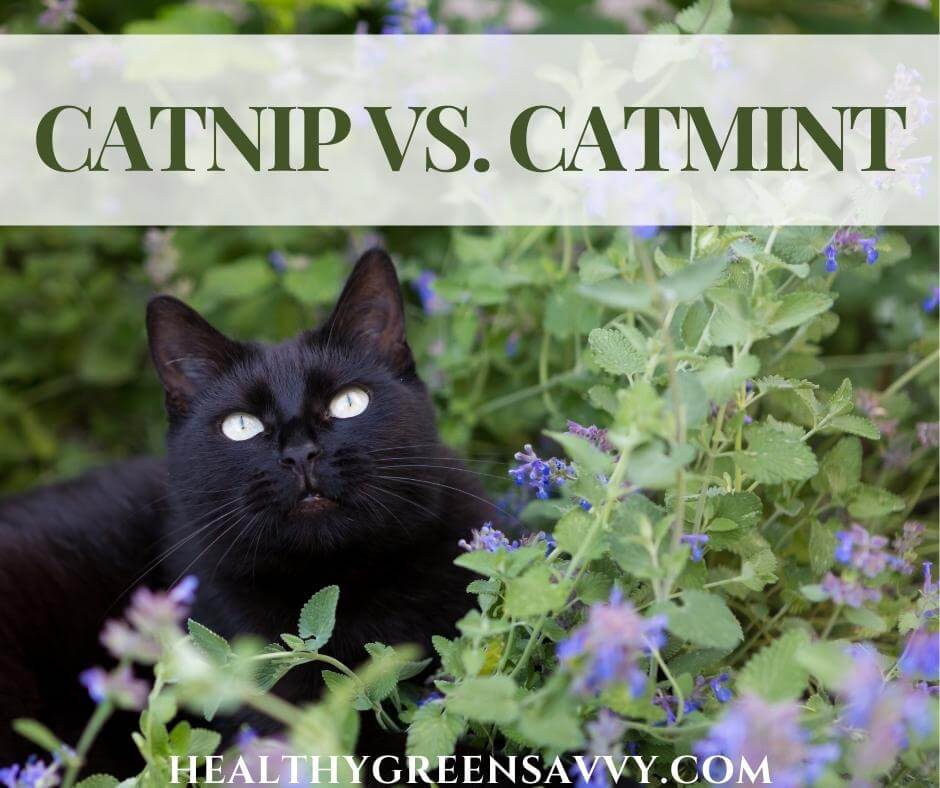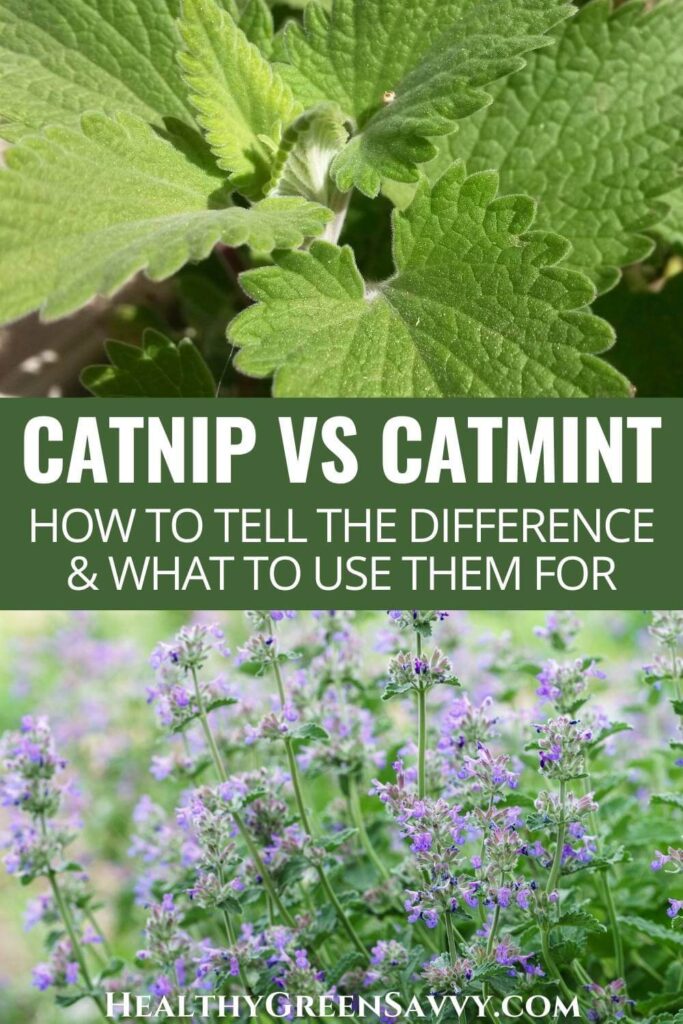Last Updated on November 13, 2024
Have you heard that there are medicinal benefits of catnip — or is it catmint? — and wondered whether that plant in your garden might wind up in your teapot? Here’s what to know about catnip vs catmint and which herb to use for medicinal benefits.

Inside:
- Distinguishing catnip vs catmint
- Can humans eat catnip?
- Catnip benefits for humans
- Catnip medicinal uses
- Where to get catnip and catmint
CATNIP VS CATMINT: WHAT’S THE DIFFERENCE BETWEEN CATNIP AND CATMINT ANYWAY?
Let’s start with a little clarification, since catnip and catmint are so often confused. (Like pine and spruce! Here’s how to tell spruce vs fir vs pine if you’re curious.)
Is catmint the same as catnip? Though both are members of the mint family and in the genus Nepeta, they are in fact different species, though they’re often called by the same name.
Catnip (Nepeta cataria) contains more of the compound called nepetalactone that cats find so attractive and it’s what you’ll most often find used in catnip treats and toys for cats.
Catmint species sold in garden centers typically include Nepeta faassenii, Nepeta grandiflora, or Nepeta racemosa, but there are many more catmint species around the world.
Catmint is generally considered more attractive and well-behaved in the garden than its cousin catnip and is often used as a landscape plant.
Catmint is prized for its toughness and drought-tolerance. Cats like it OK, but they won’t go crazy for it the way they do for catnip.
One of the reasons catnip and catmint are so often confused is that in many parts of the world the catnip plant (Nepeta cataria) is also called catmint. Herbalist Maud Grieve, for example, lists catmint as Nepeta cataria in her beloved book, A Modern Herbal because in Britain that’s the name more often used for the plant known in many other parts of the world as catnip.
Some claim that both catnip and catmint can be used medicinally, though documented herbal uses of catmint are extremely scarce. Even herbalists writing about these two plants often conflate them or use common names for the plants that don’t distinguish between them.
It’s catnip (Nepeta cataria) that’s widely used medicinally. Perhaps its higher concentration of cat-attracting nepetalactone also explains catnip’s medicinal benefits for humans.
If you’d like to try it for yourself, after you’ve correctly identified catnip (or bought some dried), find out how to make catnip tea.
HOW TO IDENTIFY CATNIP VS CATMINT
Identifying catnip vs catmint is easy once you get familiar with the two plants. You can tell catnip from catmint pretty readily by growth habit and leaf shape.
To identify catnip vs catmint: Catnip has a more upright, rangy growth habit and larger leaves than catmint. Flowers are usually white, sometimes with a pinkish tinge. Catmint’s flowers are usually purple, and the leaf shape and growth pattern differ from catnip, as you can see in the photos below. Once you’re familiar with these traits, you’ll never have trouble telling the difference between catnip and catmint again.

Catmint leaves (photo credit: lwccts)
If you go to purchase plants at a nursery, you’ll likely find at least one if not more kinds of catmint sold with the ornamental perennials, as it’s a very popular landscape plant. Here’s what it looks like in flower:

If it’s sold at all, you might find the less attractive catnip plant with the culinary herbs. I’ve seen it on occasion at our local nursery and at farm stands selling potted herbs.
You can likely get both catnip and catmint from neighbors, one of the many ways to get plants free. Just go take a look at it for yourself before accepting someone’s offer of catnip or catmint, because odds are they don’t know the difference between them!
I’m speaking from experience. When I put out a request for catmint in a local plant exchange group, one kind member dug up a huge clump of catnip for me and deposited it at my door. I planted it in an out-of-view spot since I like using catnip in tea and then went and asked a neighbor to dig up a division of her pretty low-growing catmint to transplant to the front garden.
IS CATMINT EDIBLE? CAN YOU EAT CATMINT? WHAT ABOUT CATNIP?
With all the confusion about names, most searches for whether catmint is edible will take you to a post actually describing catnip, which definitely is edible and has many studied medicinal uses.
I found one article claiming Nepeta x faassenii was edible and another saying Nepeta racemosa was, but neither author cited any sources and may have just been repeating information about catnip where it had been called by its common name catmint. So confusing!
I found one study in PubMed that included catmint among the edible flowers it examined, suggesting that indeed catmint is also edible. This metastudy covers numerous Nepeta species (including several catmints) and reports that many had high concentrations of antioxidants and compounds with antimicrobial and other properties. This study looked at similar traditional uses of different catmints in various parts of the world.
This study of 72 patients with depression given Nepeta menthoides suggests it may have use as an anti-depressant.
Given how little reliable information we have about catmint, I suggest proceeding with caution with Nepeta species other than Nepeta cataria unless you find something more definite. I’m going to get my hands on some additional herbal medicine books and see if I can find anyone else confirming catmint’s rather than catnip’s edibility.
I love the advantages of growing catmint in the perennial garden, and I may try a little catmint in my tea this season, but I’m going to stick with the better-studied catnip for regular medicinal use.
CATNIP MEDICINAL USES FOR HUMANS
Catnip and some types of catmint have been used medicinally around the world for centuries, and some modern research has supported these uses. Traditional uses for catnip include:
- Sleep aid
- Muscle relaxant
- Digestive aid
- Stress reliever
- Antimicrobial
- Antiviral
- Immune support
- Respiratory support
Native Americans used catnip for a range of uses including colds, headaches, and fevers, especially in children.
In The Green Pharmacy, renowned ethnobotanist James Duke writes that catnip may be helpful for preventing cataracts, promoting sleep, and for treating amenorrhea. This use aligns with the Cherokee use of catnip as an abortifacient, so it’s probably best to avoid catnip in pregnancy.
This overview of pharmacological uses around the world also reports that members of the Nepeta genus contain compounds that have anti-inflammatory, immune-modulating, antimicrobial, antioxidant, and other properties and have been used to treat malaria, chickenpox, tuberculosis, measles, as well as respiratory, digestive, and other complaints.
This study looked at a combination of lemon balm and Nepeta menthoides and found it helped with insomnia, depression, and anxiety.
An oil derived from catnip rich in nepetalactone has been found to be effective for repelling mosquitoes and other insects. Try it in your next DIY bug repellent and see what you think. Catnip is also considered useful in companion planting. It’s among many rhubarb companion plants to explore.
USING CATNIP MEDICINALLY
The most common way to use catnip medicinally is in herbal tea. You can make a simple tea from a teaspoon or two of dried catnip (or 1 to 2 tablespoons fresh catnip) per cup of boiling water.
I’ve been putting catnip leaves from the garden in my fresh herbal tea blends for years. Catnip is one of the more useful herbs for sleep you can grow yourself. I don’t love the taste of fresh catnip on its own, though, so I usually combine it with lots of other herbs growing in my yard, including wild violets, yarrow, and lemon balm.
Dried catnip makes for a mintier and more pleasant tea if you want to try it on its own, without other herbs.
Here’s how to make lemon balm tea, which is quite tasty with a little catnip, an excellent evening beverage to encourage relaxation and better sleep.
If you prefer, you can also tincture your catnip or buy a catnip tincture ready-made. If you want to make your own, here’s how to make a tincture from the Herbal Academy.
WHERE TO GET CATNIP FOR HERBAL USES
If you want to try catnip tea or add catnip to your evening tea blends, you can grow it yourself or buy it dried and ready to use. Vitacost has the best price I’ve found on bulk catnip, and their frequent sales make saving on herbs, pantry staples, and body care so much more affordable. You can get catnip at Amazon as well, though it costs more.
Looking to save a little cash on your healthy living staples? Check out these savvy ways to save money on healthy products you can find online.
If you want to grow your own catnip or catmint, you can get a free division from a friend or neighbor (just be sure it’s the plant you want!), buy a plant start at a nursery, or grow it from seed. Seeds Now carries seeds for both catnip and catmint.
Catnip grows readily from seed and can be a bit weedy, having a tendency to spread easily by seed and popping up in odd places around the garden. I don’t really mind finding catnip in new spots around my edible landscape, so I just harvest more for my tea. If you want to keep your catnip under control, cut flowers off and use or dry them before they have a chance to set seed.
Catmint is better behaved and will stay where you put it. If you want more, you can take divisions from the original plant after a couple of years and transplant them to other parts of the garden.
Here’s more on catmint cultivars and growing tips.
Some other commonly-confused plants to explore: goldenrod vs ragweed, birch vs aspen, and spurge vs purslane. It’s important to learn how to distinguish valuable edible wild plants from look alikes, some of which are poisonous.
Do you grow catmint or catnip? What do you like to do with them? Please share in the comments!
Pin to save this info on catnip vs catmint & health benefits of catnip for later!
Disclaimer: I’m a health enthusiast, not a medical professional. Content on this website is intended for informational purposes only and is not meant to provide personalized medical advice. I draw on numerous health sources, some of which are linked above. Please consult them for more information and a licensed professional for personalized recommendations.
Additional catnip vs catmint photo credits: w-ings, ikuyan

Susannah is a proud garden geek and energy nerd who loves healthy food and natural remedies. Her work has appeared in Mother Earth Living, Ensia, Northern Gardener, Sierra, and on numerous websites. Her first book, Everything Elderberry, released in September 2020 and has been a #1 new release in holistic medicine, naturopathy, herb gardening, and other categories. Find out more and grab your copy here.




 Hi, I'm Susannah, a garden geek, energy nerd, and fan of healthy food and natural remedies. Need some simple, practical solutions for living healthier and greener? You've come to the right place! More about me and my green projects
Hi, I'm Susannah, a garden geek, energy nerd, and fan of healthy food and natural remedies. Need some simple, practical solutions for living healthier and greener? You've come to the right place! More about me and my green projects
Leave a Reply